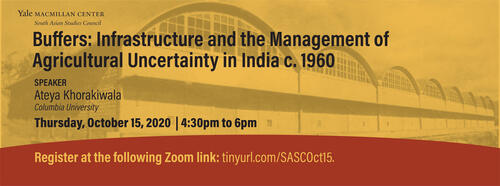“Has the buffer been built purely for the sake of form?”
This question was posed twice to the audience by Ateya Khorakiwala, both as she began and concluded her October 15 talk. The question — and Khorakiwala’s eloquent analysis of its history and context — brought together another thought-provoking installment of the South Asian Studies Council’s popular Colloquium Series.
Dr. Khorakiwala, who is an Assistant Professor in Columbia University’s Graduate School of Architecture, is an architectural historian whose research focuses on the infrastructural environments of the developmental Indian state. In this talk, titled “Buffers: Infrastructure and the Management of Agricultural Uncertainty in India,” Khorakiwala offered a concise but powerful argument: that the function of buffer stocks of food grain in post-Independence India was not merely economic or biological, but also aesthetic.
Between 1950 and 1975, Khorakiwala explained, the Indian state developed a highly technocratic system of distributing food, one motivated by a sharp desire to transform the country’s body politic in response to a memory of decades of hunger and famine. These fears, she argued, deeply informed the very existential identity of the post-colonial state, and went on to transform its built environment, both rural and urban. Indian architectural modernism was deeply influenced by famine, food shortages and hunger; wheat and rice storage grew to be embedded in the most basic techniques of the state.
Dearth, clarified Khorakiwala, marked not just the terrible examples of widespread famine that are still remembered today, but also small pockets of hunger that continued to sporadically plague the Indian subcontinent. This motivated the colonial state to draft the 1880 Famine Code — a piece of which mandated public works projects to extract labor and provide peasants the financial means to secure food. The legacy of these codes was long-lasting, and can even be seen in 21st century legislation like the 2005 MGNREGA legislation. As Khorakiwala noted, the 2005 law has “its roots in the moral and biopolitical logic of the 1880 code.”
As new forms of technical knowledge based in statistics and new moral concepts like sovereignty and self-sufficiency came to the fore, the buffer also took on specific form in the silo. The silo, Khorakiwala explained, brought together three major concerns in the post-Independence developmental state: the threat of famine, the need for population management, and, in conditions where increasing amounts of wheat were imported from the USA to solve India’s food needs, the desire for sovereignty. In this context, Khorakiwala contends that “food storage emerged as a key political technology with which to manage the political economy of food and hunger.”
However, as she noted, silos have often failed in their technocratic motives — a fact that itself has a long colonial history, and one Khorakiwala made clear by referring to an 18th century granary built by Governor General William Hastings following a famine in Bengal. The site, like many other buffers, is now obsolete, and as Khorakiwala put it, “empty silos are hardly unfamiliar to us.”
However, silos did not serve merely functional purposes; or rather, their “function” must be understood in expanded ways. For modern architects, particularly Le Corbusier, silos epitomized modernity. The concept of storage became central to architectural modernity, and soon entangled governmentality and citizenship. In its obsession to prevent famine, the state began to fashion itself as benevolent hoarder, and required physical expressions of this fashioning. Silos played a significant role in this regard, Khorakiwala said. “While the tools of price management are abstract, their guarantee — the wheat reserve, the buffer stock — is physical, volumetric, corporeal, and need I say, alive.”
Along with American wheat, therefore, also came pre-fabricated storage structures: lightweight sheets of galvanized steel. In Nehruvian India, these carried significant aesthetic meaning alongside their other architectural markers. “Where the damn was iconic of increased productivity,” Khorakiwala noted, “the shell reinforced the stabilization of the market.” It hoped to de-biologize and economize wheat, and deploy a quantitative architecture against the monstrous incalculability of its market. Silos, argued Khorakiwala, served to preserve an economic and biological limbo, and maintain a statis. Their real work was not to shelter grain, but to produce rhetorics of the developmental state in physical form.
A full recording of Khorakiwala’s talk, as well as an engaging Q&A with Professors Sivaramakrishnan and Acciavatti that followed it, can be accessed here.


